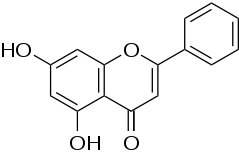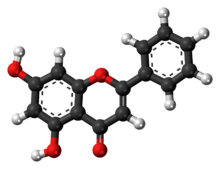Chrysin
 | |
 | |
| Names | |
|---|---|
| IUPAC name
5,7-Dihydroxy-2-phenyl-4H-chromen-4-one | |
| Other names
5,7-Dihydroxyflavone; NP-005901; Galangin flavanone | |
| Identifiers | |
3D model (JSmol) |
|
| ChEBI | |
| ChEMBL | |
| ChemSpider | |
| ECHA InfoCard | 100.006.864 |
| KEGG | |
PubChem CID |
|
| UNII | |
| |
| |
| Properties | |
| C15H10O4 | |
| Molar mass | 254.24 g·mol−1 |
Except where otherwise noted, data are given for materials in their standard state (at 25 °C [77 °F], 100 kPa). | |
| Infobox references | |
Chrysin, also called 5,7-dihydroxyflavone,[1] is a flavone found in honey, propolis, honeycomb, the passion flowers, Passiflora caerulea and Passiflora incarnata, and in Oroxylum indicum.[1][2] Commercially, it is extracted from blue passion flowers.[1] Chrysin is an ingredient in dietary supplements, but its efficacy and safety have not been adequately defined.[3]
Occurrence
Present in carrots and flowers of some plants, chrysin is a dihydroxyflavone, a type of flavonoid.[4] It has been isolated from honey, propolis, honeycomb, and the passion flowers, Passiflora caerulea and Passiflora incarnata, and from Oroxylum indicum.[1][2] It is also found in chamomile and in the mushroom, Pleurotus ostreatus.[5]
One study determined that the amount of chrysin in honey from various plant sources is about 0.2 mg per 100 g.[6] Chrysin is typically found at higher amounts in propolis than in honey.[7]
Bioavailability
Following oral intake by humans, chrysin has low bioavailability and rapid excretion.[8][9]
Supplement
Although chrysin is an ingredient in dietary supplements and topical medications intended to improve physical performance or treat various clinical conditions, its safety, efficacy, and history for use in compounding remain undefined.[3]
Safety
Preliminary determinations from oral consumption of chrysin indicate a daily amount of 0.5 to 3 g is safe,[4] although other reviews describe that its safety is not yet adequately evaluated.[3] It is not recommended for use as an ingredient in topical medications.[3]
Research
As of 2016, there is no evidence for chrysin in human clinical applications and its use for compounding of therapeutic agents is not recommended.[3] Research showed that orally administered chrysin does not have clinical activity as an aromatase inhibitor.[10]
References
- 1 2 3 4 "Chrysin: Compound Summary for CID 5281607". PubChem, National Center for Biotechnology Information, US National Institutes of Health. 28 October 2017. Retrieved 29 October 2017.
- 1 2 Morissette M, Litim N, Di Paolo T (18 May 2017). "Chapter 2 – Natural Phytoestrogens: A Class of Promising Neuroprotective Agents for Parkinson Disease". In Brahmachari G. Discovery and Development of Neuroprotective Agents from Natural Products. Elsevier Science. p. 32. doi:10.1016/B978-0-12-809593-5.00002-1. ISBN 978-0-12-809769-4.
- 1 2 3 4 5 Brave M (23 June 2016). "Chrysin" (PDF). Pharmacy Compounding Advisory Committee, Division of Oncology Products, US Food and Drug Administration. Retrieved 28 October 2017.
- 1 2 Samarghandian S, Farkhondeh T, Azimi-Nezhad M (2017). "Protective Effects of Chrysin Against Drugs and Toxic Agents". Dose-response : a Publication of International Hormesis Society. 15 (2): 1559325817711782. doi:10.1177/1559325817711782. PMC 5484430. PMID 28694744.
- ↑ Anandhi R, Annadurai T, Anitha TS, Muralidharan AR, Najmunnisha K, Nachiappan V, Thomas PA, Geraldine P (June 2013). "Antihypercholesterolemic and antioxidative effects of an extract of the oyster mushroom, Pleurotus ostreatus, and its major constituent, chrysin, in Triton WR-1339-induced hypercholesterolemic rats". Journal of Physiology and Biochemistry. 69 (2): 313–23. doi:10.1007/s13105-012-0215-6. PMID 23104078.
- ↑ Istasse T, Jacquet N, Berchem T, Haubruge E, Nguyen BK, Richel A (2016). "Extraction of Honey Polyphenols: Method Development and Evidence of Cis Isomerization". Analytical Chemistry Insights. 11: 49–57. doi:10.4137/ACI.S39739. PMC 4981221. PMID 27547032.
- ↑ Premratanachai P, Chanchao C (2014). "Review of the anticancer activities of bee products". Asian Pacific Journal of Tropical Biomedicine. 4 (5): 337–44. doi:10.12980/APJTB.4.2014C1262. PMC 3985046. PMID 25182716.
- ↑ Walle T, Otake Y, Brubaker JA, Walle UK, Halushka PV (February 2001). "Disposition and metabolism of the flavonoid chrysin in normal volunteers". British Journal of Clinical Pharmacology. 51 (2): 143–6. doi:10.1111/j.1365-2125.2001.01317.x. PMC 2014445. PMID 11259985.
- ↑ Nabavi SF, Braidy N, Habtemariam S, Orhan IE, Daglia M, Manayi A, Gortzi O, Nabavi SM (2015). "Neuroprotective effects of chrysin: From chemistry to medicine". Neurochemistry International. 90: 224–31. doi:10.1016/j.neuint.2015.09.006. PMID 26386393.
- ↑ Saarinen N, Joshi SC, Ahotupa M, Li X, Ammälä J, Mäkelä S, Santti R (September 2001). "No evidence for the in vivo activity of aromatase-inhibiting flavonoids". The Journal of Steroid Biochemistry and Molecular Biology. 78 (3): 231–9. doi:10.1016/S0960-0760(01)00098-X. PMID 11595503.